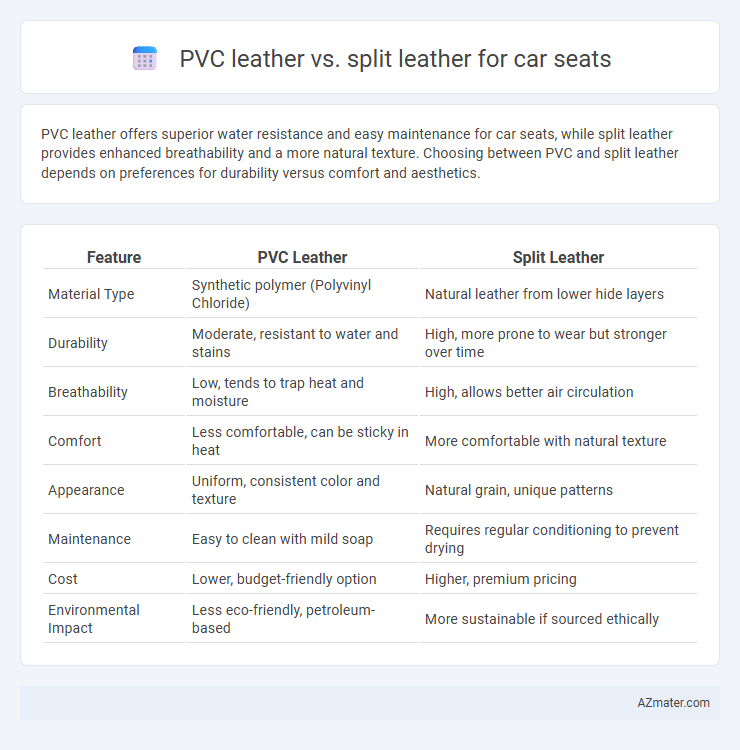PVC leather offers superior water resistance and easy maintenance for car seats, while split leather provides enhanced breathability and a more natural texture. Choosing between PVC and split leather depends on preferences for durability versus comfort and aesthetics.
Table of Comparison
| Feature | PVC Leather | Split Leather |
|---|---|---|
| Material Type | Synthetic polymer (Polyvinyl Chloride) | Natural leather from lower hide layers |
| Durability | Moderate, resistant to water and stains | High, more prone to wear but stronger over time |
| Breathability | Low, tends to trap heat and moisture | High, allows better air circulation |
| Comfort | Less comfortable, can be sticky in heat | More comfortable with natural texture |
| Appearance | Uniform, consistent color and texture | Natural grain, unique patterns |
| Maintenance | Easy to clean with mild soap | Requires regular conditioning to prevent drying |
| Cost | Lower, budget-friendly option | Higher, premium pricing |
| Environmental Impact | Less eco-friendly, petroleum-based | More sustainable if sourced ethically |
Introduction to Car Seat Upholstery Materials
Car seat upholstery materials primarily include PVC leather and split leather, each offering distinct benefits for automotive interiors. PVC leather is a synthetic material known for its durability, resistance to stains, and ease of maintenance, making it a popular choice for budget-friendly and low-maintenance car seats. Split leather, derived from the lower layers of animal hides, provides a genuine leather feel with enhanced breathability and softness, often preferred for premium car seat designs requiring a balance of luxury and comfort.
What is PVC Leather?
PVC leather, also known as polyvinyl chloride leather, is a synthetic material commonly used for car seats due to its durability, water resistance, and ease of maintenance. It is made by coating a fabric base with a layer of PVC plastic, creating a flexible and leather-like surface that resists stains and fading. Compared to split leather, PVC leather is generally more affordable and requires less upkeep but may lack the breathability and natural feel of genuine leather materials.
What is Split Leather?
Split leather is a type of natural leather made from the lower layers of a hide after the top grain is separated, offering a softer texture but less durability compared to full-grain leather. In car seats, split leather is often coated or embossed to mimic the appearance of top-grain leather while providing enhanced affordability. Unlike PVC leather, which is synthetic and less breathable, split leather maintains some natural leather properties such as breathability and comfort, making it a preferred choice for mid-range automotive upholstery.
Durability: PVC Leather vs Split Leather
PVC leather offers superior durability for car seats due to its resistance to scratches, stains, and fading, ensuring a longer lifespan under regular use. Split leather, made from the fibrous part of the hide, tends to wear faster and is more prone to cracking and peeling compared to PVC leather. Manufacturers often choose PVC leather for its low maintenance and enhanced durability in automotive interiors.
Comfort and Feel Comparison
PVC leather offers a smooth and consistent surface that is water-resistant and easy to clean, making it practical for car seats but often feels less breathable and can become sticky in hot weather. Split leather, derived from the lower layers of the hide, provides a softer and more breathable texture that enhances comfort during long drives but may require more maintenance to retain its quality. The choice between PVC leather and split leather depends on prioritizing durability and easy upkeep versus superior comfort and natural feel.
Aesthetics and Design Options
PVC leather offers a sleek, uniform appearance with a wide range of color and texture options, making it highly versatile for modern car seat designs. Split leather features a more natural grain and richer texture, giving car interiors a luxurious and authentic look. Design options for PVC leather often include customizable embossing and finishes, while split leather emphasizes unique, organic patterns enhancing the aesthetic appeal of premium vehicles.
Maintenance and Cleaning Requirements
PVC leather offers superior ease of maintenance and cleaning, requiring only a simple wipe-down with a damp cloth to remove dirt and spills, making it highly resistant to stains and fading. Split leather demands more attentive care, including regular conditioning and gentle cleaning with specific leather products to prevent drying, cracking, and discoloration over time. Both materials benefit from avoiding harsh chemicals, but PVC leather's synthetic nature allows it to endure more rigorous cleaning methods without damage.
Cost Differences
PVC leather for car seats offers a more budget-friendly option compared to split leather, typically costing 30-50% less due to its synthetic production process. Split leather, derived from the fibrous lower layer of animal hides, commands a higher price because of its natural durability and premium texture. The cost differential reflects not only material quality but also the labor-intensive manufacturing involved in processing genuine leather for automotive upholstery.
Environmental Impact
PVC leather for car seats produces significant environmental pollution due to its non-biodegradable nature and release of toxic chemicals during manufacturing and disposal. Split leather, derived from the lower layers of animal hides, involves intensive tanning processes that consume large amounts of water and release harmful effluents containing heavy metals. Sustainable alternatives prioritize eco-friendly tanning methods and biodegradable materials to minimize the ecological footprint of automotive upholstery.
Which is Best for Your Car Seats?
PVC leather offers superior water resistance and easy maintenance, making it ideal for families or frequent drivers who need durability and quick cleaning. Split leather, derived from the lower layers of cowhide, provides a more natural look and breathability but requires more care and is prone to wear over time. Choosing the best material depends on whether you prioritize durability and cost-effectiveness (PVC leather) or comfort and premium aesthetics (split leather) for your car seats.

Infographic: PVC leather vs Split leather for Car seat
 azmater.com
azmater.com